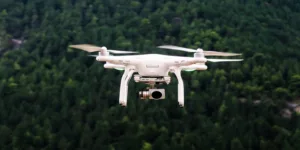Drone technology is exploding in both sophistication and adoption. They’re expected to grow to become a $21.23 billion market by the year 2022, but already, they’re starting to make an impact on how we live and work.
Though drones have a variety of potential applications, including use by the military and personal entertainment, one of the biggest potential areas for growth remains in augmenting certain professional services. These types of drones are made to make certain jobs easier, more efficient, or more accurate, and thanks to the positive ROI they lend these investing businesses, they’re already poised for widespread adoption.
Top Professional Applications
So what types of professional applications will spur the most growth in drone technology?
- Surveying and mapping. There are many needs for accurate mapping and surveying, such as mining, aggregate and stock pile volume measurement, geology, landslides, larger construction sites, and golf courses. Drones make traditional aerial photography much more flexible, accessible, and efficient, and can also provide detailed topographical maps of a given location. Software platforms like PhotoModeler allow you to survey and map using drones, creating a digital 3D model or an orthophoto that can be used for virtually any application. City planners can also make use of this technology to analyze things like street layouts and geographical limitations for new construction.
- 3D modeling. Then, there’s 3D modeling, which can be used to scan and store information on a given 3D object for practically any purpose. 3DR site scan, for example, works with drone-based cameras to get a full view of a target object, then provide that object’s data to architects, designers, researchers, or even forensic analysts to improve that object or use it in further applications. PhotoModeler software can be used for this as well.
- Inspections. Software like DroneDeploy is making it easier to use drones for onsite inspections, usually of commercial buildings (and can also be used for surveying and 3D modeling). Hiring a drone pilot to fly an unmanned unit is usually far less expensive than insuring people to climb and inspect the outside of the building themselves. In fact, on most job sites, a drone can complete the inspection within 30 minutes. The footage gathered while inspecting the building can also be used in the future, for marketing materials, so professionals in construction, insurance, and marketing industries all have something to gain here.
- Surveillance. In one of the most controversial applications for drones, these unmanned aerial vehicles can be used for security and surveillance. Because these units can be equipped with conventional cameras, infrared cameras, heat sensor, and even radar, it’s possible to get a more detailed view of your surroundings for far less than it would cost for a robust (yet stationary) security camera system, or hired security guards. The biggest limiting factor here are the currently ambiguous laws protecting civilian privacy in the emergence of these ever-present monitors. Even if legislation becomes stricter, this will still be a prospective area for massive growth in the near future.
- Film & Photography. Finally, don’t forget that the cameras carried by drones can still be used for conventional photography—whether that means creating an aerial shot to show off on a website, or filming scenes for a movie. In fact, blockbusters like Captain America: Civil War and Jurassic World filmed many scenes using drone technology, and it’s likely going to become more popular as directors realize the potential uses for such equipment.
The Holdup
With the state of modern drone technology, you might expect industries everywhere to have at least a handful of drones on deck, but the reality is, growth in the drone sector is just beginning. Despite claims that drones “went mainstream” in 2015, or even back in 2013, drone technology is still limited to mostly industrial and military applications. This is partially because drone technology is comparatively expensive for small businesses and one-person operations, and partially because no single drone technology has been the breakthrough, “game changing” experience that can serve as a kind of technological gateway drug. FAA regulations are another key influencing factor, as certain locations—such as over people and roads—are highly restricted, preventing drone operators and developers from having total freedom to experiment or perform.
Still, it’s only a matter of time before the market catches up with consumer expectations and the impressive numbers forecasted by industry analysts. Look forward to new growth in the drone industry, fueled by the previously listed professional applications.








